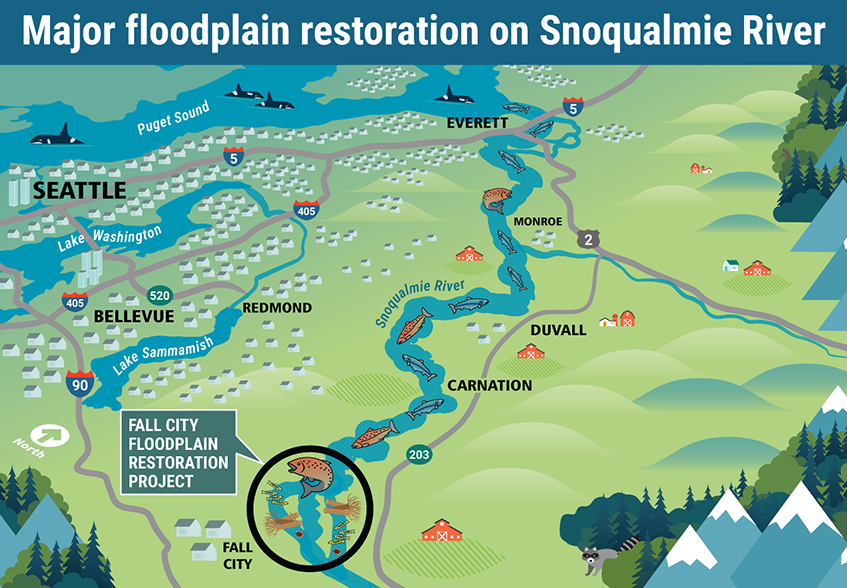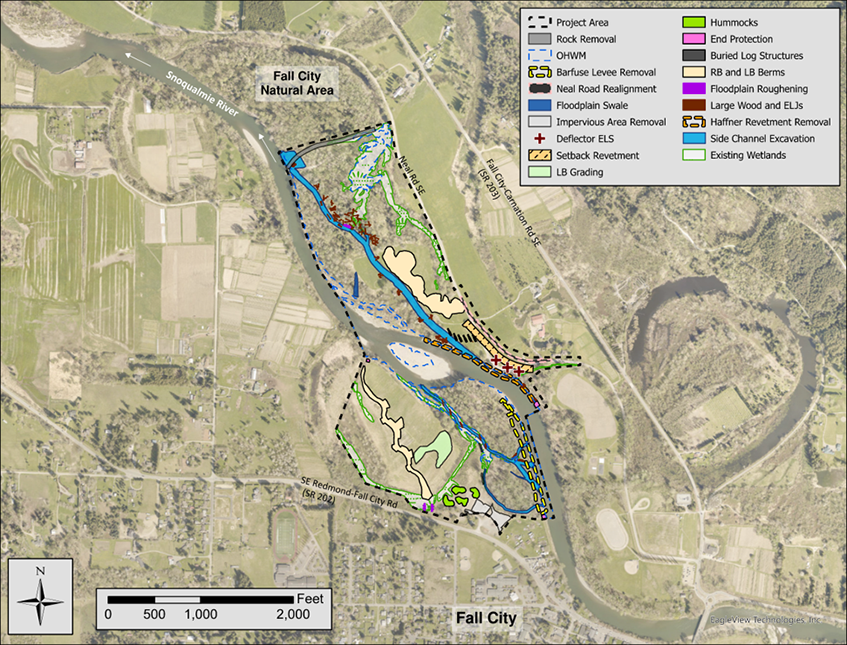Fall City Floodplain Restoration Project
Project location
The project, formerly referred to as the Haffner-Barfuse Project, encompasses two river facilities (one levee, one revetment) that are across from each other on the mainstem Snoqualmie River, about a half-mile downstream of the SR-202 Bridge in the town of Fall City.

The challenge
Chinook salmon, bull trout, and steelhead trout salmon are now at less than 10 percent of their historic population and are listed as threatened under the Endangered Species Act (ESA). The Southern Resident Orca population, reliant on the Chinook for their food source, is on the brink of extinction. A significant barrier to salmon recovery on the Snoqualmie river is a lack of good juvenile rearing habitat. The ideal rearing habitat is currently inaccessible to the young fish, trapped behind man-made levees and revetments that were built to protect residents and properties.
Project goals
- Increase the quantity and diversity of habitat for Snoqualmie River salmon.
- Maintain or improve existing level of off-site flood and erosion protection for agricultural land, residences, and Neal Road Southeast.
- Restore natural river process, such as channel migration, wood recruitment, and gravel bar formation.
Project elements
This project is actually the implementation of two projects – the removal and setback of the Haffner revetment on the right bank of the Snoqualmie River and the removal and setback of the Barfuse levee on the left bank. The two were designed and constructed together to address regulatory restrictions related to flooding and also to save on costs.
Right bank - Haffner site:
- Remove approximately 1,400 feet of revetment to restore edge habitat and channel migration potential.
- Improve the connection of the river with its floodplain which will help facilitate habitat-forming processes in approximately 100 acres of floodplain.
- Construct an estimated 3,100 feet of side channel in the floodplain to address zero-rise issues from levee removal on the left bank and to increase off-channel habitat.
- Relocate approximately 1,300 feet of Neal Road to maintain public safety and access to private properties.
- Construct an estimated 900-foot setback revetment along Neal Road Southeast, including log structures to protect the road and private property from channel migration.
- Control invasive weeds and plant native vegetation on approximately 100 acres to increase forest cover and vegetative diversity along waterways and in the floodplain.
Left bank – Barfuse site:
- Remove approximately 1,300 feet of a levee to restore edge habitat and channel migration potential.
- Improve the river’s connection to approximately 45 acres of its floodplain, including historic side channels.
- Construct an estimated 2,000-foot berm to provide necessary flood protection for adjacent properties and infrastructure.
- Control invasive weeds and plant native vegetation on approximately 45 acres to increase forest cover and vegetative diversity along waterways and in the floodplain.

Project benefits
The key driver for the project is to improve the quantity and diversity of habitat for Endangered Species Act-listed Chinook salmon. A healthy and connected floodplain provides a diversity of habitat types to meet the needs of a salmon, like side channels, log jams, and complex edges preferred by rearing juvenile salmon. The project provides 145 acres of connected floodplain and just over a 1 mile of constructed or reconnected side-channels. The entire project footprint is enhanced with native vegetation that will grow into the functioning floodplain forest. The entire project footprint will be enhanced with native vegetation that will grow into the functioning floodplain forest.
The project is expected reduce erosive flood damage and inundation in the project vicinity, lowering floodwater levels on approximately 300 surrounding acres. The new Haffner revetment is set at more sustainable alignment and brought up to modern construction standards. Additionally, the newly realigned Neal Road Southeast will be less prone to flood damage.
As the project matures and plants and trees grow up, they will help to keep water cool and clean, improving water quality for fish and downstream residents.
Snoqualmie Watershed salmon recovery
The 1999 listing of Chinook salmon as threatened under the ESA triggered the need to develop a plan to increase productivity of the Snoqualmie Chinook population. The Snohomish River Basin Salmon Conservation Plan prioritized juvenile rearing in geographic areas like river reaches and actions to better guide efforts to restore the population. The mainstem Snoqualmie, Tolt, and Raging rivers were historically very productive for Chinook and other salmonids (salmon and trout).
However, the habitat needed for salmonid spawning and rearing has been substantially reduced as a result of landscape and river changes, such as levees and revetments built to contain rivers. Salmonids need clean gravel to make salmon nests (redds) and refuge areas, especially in the vicinity of their redds, for when they emerge from their eggs. Refuge areas of slow-moving waters associated with floodplain side channels, log jams and complex river edges provide hiding places from predators and relief from strong river currents. The forces of those waters can damage roads, homes and move large trees and boulders.
This project is one of the many salmon recovery projects that need to be implemented to restore critical rearing habitat such as natural river shorelines, gravel bars, and floodplain side channels that have been lost or degraded. The Haffner and Barfuse projects were identified and prioritized in the Salmon Recovery Funding Board (SRFB)-funded Snoqualmie at Fall City (SAFC) Reach Restoration Assessment (2011). This Assessment recommended pursuing a reach-scale, long-term restoration effort referred to as “The Corridor Project” which not only restores salmon habitat but also restores natural river processes that are resilient to climate change and self-sustaining over time.
Design and construction of the project will be the second and third projects towards realizing this larger-scale vision that will allow unconstrained riverine processes to act on over 145 acres of the floodplain. The Upper Carlson Project was the first project implemented in this reach.
Snoqualmie Fish, Farms, and Flood
King County plays an important role in salmon recovery, the protection and enhancement of farmland, and reduction of risks to residents and infrastructure from flooding. It can be challenging to balance these needs within a shared landscape.
In 2013, King County Executive Dow Constantine assembled representatives from throughout the Snoqualmie Valley to explore the issues that were creating obstacles and conflict, and to advise King County on how to overcome them. They included a cross-section of agricultural, salmon recovery and flood risk reduction interests, as well as tribal, state and local jurisdictions. Through a collaborative process the committee identified strategies to improve conditions for fish, farm and flood risk management.
In 2017, the Snoqualmie Fish, Farm, and Flood (FFF) Advisory Committee forged the first major agreement in King County to strike a balance between farming interests and salmon recovery. The Advisory Committee unanimously agreed to a set of 34 recommendations that, if funded and implemented, would significantly improve ecological function and habitat quality, while at the same time strengthening the agricultural economy, and reducing flood risk. The Fall City Floodplain Restoration Project is the first salmon recovery project scheduled for implementation under the FFF 1.0 agreement.
Project timeline

Project construction was phased over two years, 2022 and 2023. The left-bank (Barfuse) project site earthwork was completed in summer 2022 and construction on the right-bank (Haffner) was completed in 2023.
Public involvement opportunities
As part of the design process King County hosted an online open house and virtual public meeting in Fall 2020 to share design progress and solicit feedback from the community. Review the virtual open house and responses or watch a recording of the virtual public meeting to learn more details about the project. Use the sign up box above to receive project updates.
Project documents
- SEPA Determination of Non-Significance (DNS), Jan. 2021 (216 KB)
- SEPA Environmental Checklist, Jan. 2021 (2 MB)
- 100% plans - February 2022 (56.4 MB)
- 100% large wood checklist - May 2022 (3.52 MB)
Project funding sources
The total estimated cost to implement the Fall City Floodplain Restoration Project is $19,000,000 for both sites. Projects of this scale and nature are typically funded by various sources including competitive grants for the purpose of salmon recovery, improving watershed health, reducing flood and erosion risk and increasing agriculture productivity.
Funding for the project:
- Washington State Recreation and Conservation Office
- King County Cooperative Watershed Management Grant (King County Flood Control District)
- Surface Water Management Fees
- Washington State Department of Ecology – Floodplains by Design
- Snoqualmie Indian Tribe (planting portion of Barfuse project site)
- King County Parks Levy Open Space River Corridor Grant
Property acquisition grants:
- Conservation Futures Grant
- King County Flood Control District
- Washington State Salmon Recovery Funding Board

 Translate
Translate